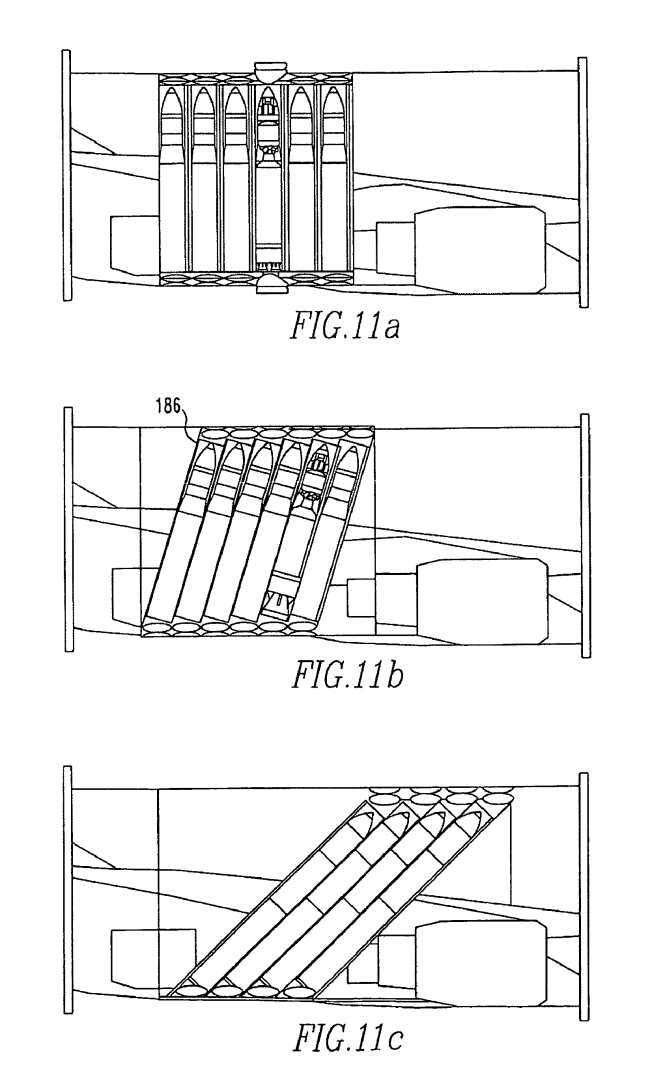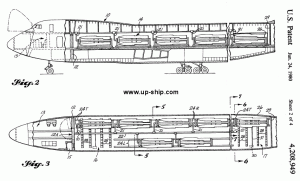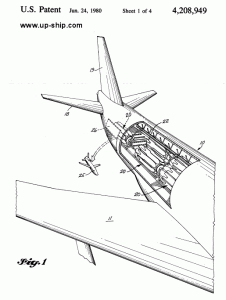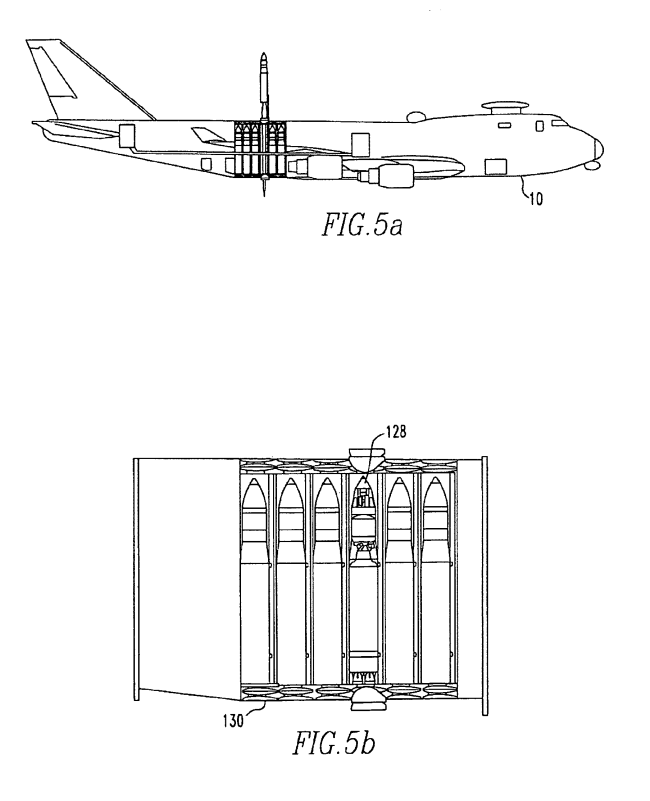A few photos of a McDonnell-Douglas display model of a DC-10 modified to launch a pair of MX (or MX-like) ICBMs. The missiles are held in pneumatic tubes, with a high pressure gas system near the nose of each missile; clearly, the missiles would not be simply slid out the back, but rather *shot* out the back with some authority. While the photos do not show the underside of the aft fuselage, clearly there has been some major modification to the design there. Less obvious is a change to the outer moldline of the upper fuselage… “bumps” are added to provide sufficient clearance for the angled missile tubes.
A Boeing painting depicting a 747 in the process of launching an MX-style ICBM. The total load was at least four such missiles. No further data than the artwork. A “bridge”-like cradle would go fore and aft carrying missiles and dropping them out a large hatch in the underside of the rear fuselage. Speculation: controlling the aircraft during the rather sudden shift in CG would have been interesting.
One Lt. Col. Dan Ward, USAF, proves that there are lessons to be learned from the Star Wars universe.
http://www.dau.mil/pubscats/ATL%20Docs/Sep-Oct11/Ward.pdf
The Death Star’s lackluster contribution to the fight is reason enough not to build one, but serious problems emerged long before it was declared operational. In Return of the Jedi, viewers gain a fascinating insight into the programmatics of Empire acquisitions. In the single most realistic scene in the whole double-trilogy, Darth Vader complains that the second Death Star construction project is … behind schedule. In fact, much of the drama in Episode VI revolves around this delay.
Consider the implications of pop culture’s most notorious schedule overrun. In the Star Wars universe, robots are self-aware, every ship has its own gravity, Jedi Knights use the Force, tiny green Muppets are formidable warriors and a piece of junk like the Millennium Falcon can make the Kessel Run in less than 12 parsecs. But even the florid imagination of George Lucas could not envision a project like the Death Star coming in on time, on budget. He knew it would take a Jedi mind trick beyond the skill of Master Yoda to make an audience suspend that much disbelief.
This, I think, is one of the best discussions of the real-world implications of Death Star thinking since “Clerks.” Read the whole article… it’s good, funny, and full of valid points.
http://www.wickedlasers.com/lasers/S3_Krypton_Series-113-63.html
Green laser, one watt. A mere $1000.
[youtube 5Tx02Up-ovw]
This thing would probably be *more* dangerous than a firearm, for the simple fact that people would likely be more willing to mess around with it like idiots. And the slightest reflection – off plastic, glass, metal, probably fricken’ *paper* – would likely be enough to dazzle someone, if not outright blind them.
Still, a one watt hand-held laser seems like it might be of some practical value. The claim is that it’s bright enough to dazzle the sensors of satellites in low Earth orbit; if this is in fact the case, you can expect that these lasers will sell like hotcakes to every government on the planet, and downward-looking satellites will start going “funny” in large numbers quite soon. Huzzah! There’s you market for new cheaper launch vehicles! Gang a dozen of these together on a finely-trainable turret with a really good telescopic sight, and mount to the payload compartment of your friendly neighborhood Xcor Lynx rocketplane, and you have an instant anti-spysat system. I wonder what these would do to solar panels…
A regular green laser is bright enough that as a sight on a gun, it is itself a dandy weapon. Play it over the face of a home invader, say, and the home invader is going to lose all interest in doing anything but getting out of the house. But with *this* thing, play it over the face of the badguy, and he’ll likely be not only permanently blinded, but maybe even *scarred* by the experience. Of course, once criminals figure that out expect to see these lasers used to do just that sort of thing. Terrorists and jackasses will have all kinds of fun with these and airplanes/cars…
Youtube has a number of videos showing people starting fires and popping balloons with green lasers less powerful than this. You might be able to hunt small varmints with this laser.
The SDASM archive has just posted a promotional film describing the “Big Stick.” This was Convairs idea for the Pluto project… a nuclear ramjet cruise missile. Capable of Mach 3 flight at an altitude of 500 feet, it would be virtually impossible to intercept, and would have virtually unlimited range. The YouTube video:
[youtube R1ROFw-36r0]
There is more on the Big Stick, including diagrams, in issue V2N1 of Aerospace Projects Review:
Another take on the idea of launching an ICBM from a large jet aircraft: shoot it out the nose.
Patented in 1977, this concept from Lockheed would involved firing a Minuteman-style ICBM through a single launch tube out the nose of a C-5 Galaxy cargo plane. Better still, within the cargo bay would be a rotary structure holding four ICBMs, much like the cylinder of a good old fashioned revolver. The bottom-most missile would be fired through the “barrel” by means of a high pressure gas charge; the cylinder would then rotate the next missile into place for firing.
Missile launcher for aircraft
All in all, this seems like one of the goofier concepts for an airborne ICBM launcher. The potential for catastrophic failures seems fairly large.
It’s always fun to learn a new word. Today’s word: the Irish/Yiddish “shemozzle.” Definition: a brawl. How it’s used:
Damn the torpedoes: Defence’s $600m blunder
The Defence Force’s long-delayed $600 million purchase of anti-submarine torpedoes has suffered another humiliating setback.
The Defence Materiel Organisation (DMO) is now tendering for translators at a reported cost of around $110,000 after it was discovered the technical documentation for the European-designed weapons are written only in Italian and French.
The situation has been described as a “shemozzle” by a top defence strategist.
A substantially less crazy-sounding idea than jetliners launching large missiles vertically, in the late 1970’s Boeing (and others) studied the use of cargo jets to carry and launch large numbers of cruise missiles.
The Carter years, for you younguns who don’t remember back that far – and for you old farts old enough to have experienced the 1970’s and managed to repress memories of that dark time – were a time of economic despair, lost jobs, industries in decline and a space program that had been basically shut down. The President was swept into office on the promise of repairing a broken nation dealing with major internal divisions, troubles in the Middle East and skyrocketing oil prices.The President, rather than bringing the nation together, turned out to be rather an incompetent boob, creating *more* division and basically mangling both the economy and foreign policy. Let us hope such times do not come again…
The 1970’s actually did look like this.
Anyway: it was a time when expensive new defense procurements were in massive doubt, the anti-nuke nuts were running rampant and the aviation industry didn’t see much in the future. But still the Soviet Union was lurking just over the horizon, so a need was seen to modernize the nuclear delivery force… on a budget. President Carters cancellation of the B-1 bomber left the US without a new manned strategic nuclear delivery system; without the B-1, all the US had was the B-52 which was starting to appear rather old and obsolete (as opposed to today, when they are two or three times as old as they were then…).
Boeing put forward the idea of using 747 cargo conversions for mass cruise missile attacks. Rotary launch racks would be carried internally in the spacious cargo bay… nine racks each holding eight ALCM’s gave a respectable loading of 72 cruise missiles, each potentially armed with a single nuclear warhead. There was a single launch port on the starboard side of the aft fuselage. The rack next to the port would eject a single missile sideways through the port, rotate the next missile into place, and then launch it. When all eight missile had been launched, the rack would slide to the left; another rack would slide aft into the position just vacated. When *that* rack was empty, the first rack would slide forward, giving room for the second rack to slide sideways, and a third rack to slide aft into position. In this way, nine racks could be carried and moved into position. It would be somewhat cumbersome, and certainly a slower process than unloading the equivalent rotary racks that the B-1A would have carried internally… but then, the B-1 could only carry three such racks.
Boeing filed for a patent on the concept in 1978 and received it in 1980.
“Missile Carrier Airplane,” US patent 4,208,949
This would have been a far easier design to bring to fruition than the BAE vertical launch concept, and would probably have had a greater total load of nuclear whoopass. However, it falls short in the all-important coolness factor, and would have been useless in the micro-satellite launch business or anti-missile duty. Since the cruise missiles, jetliners and rotary racks described thirty years ago (yeeeeesh) are still available and essentially top of the line, the concept would seem to remain valid. In recent years Boeing has discussed in somewhat vague terms the “arsenal plane” concept, where a relatively large and slow aircraft would be loaded to the gills with offensive weaponry. While their artwork has tended to show some sort of blended wing body in that role, the 747 would still be a potential candidate.
NOTE: If you liked this little post, then you’ll love Aerospace Projects Review. Go take a look. NOW. Do it.
Sometimes you see stuff that makes you sad… not because the thing itself is sad, but because you can’t legally say jack about it. Well, back when I worked at ATK I stumbled across some Powerpoint presentations on a joint ATK/BAE concept, and due to the interesting notations on the pages I felt it safest to not say a thing. BAE patented the concept a few years ago with all manner of nifty diagrams, so.. restriction lifted, I guess.
The concept? Flying ICBM launcher. This is not a new idea… the Skybolt ICBM was flying around under the wings of several bombers back in the 1960’s, and both the Minuteman and Peacekeeper ICBMs were proposed to be made air mobile at various times… typically by the relatively simple expedient of carrying them in cargo planes and shoving them out the back door. But what sets this concept apart is that the ICBMs are carried *vertically* in silos, just like on ballistic missile submarines. But here there is no compressed gas charge to blow them out; they come out hot.
The first obvious problem with the concept is that, unlike a submarine, a jet aircraft at 40,000 feet is hardly likely to just stop… thus the missile will have some pretty substantial side forces on it as it comes out, to the tune of a 500+ mile per hour air blast. Anyone who has ever tried to launch a model rocket in a stiff breeze has probably noticed the concept of “tipping force:” when the rocket is only partly exposed, the wind blowing on the front of it tries to blow it over sideways. But BAE seems to think they’ve got the problem licked: by redirecting some of the exhaust gasses into a plume firing out the top of the aircraft and just ahead of the rocket, the air flow should be diverted around the missile long enough for it to clear the silo. A neat idea… I’d love to see some full scale testing!
The second obvious concern is that aircraft skins and structures *really* don’t like having big rocket motors blasting away at them from ranges of a few feet. BAE has a solution to that, too: a short-burn, high-thrust rocket motor capable of chucking the missile into the air, but fast-burning enough so that it burns out before it actually clears the tube. The missile would then coast upwards until it was clear of the aircraft, stage off the booster, then fire up its first *real* stage and continue on its merry way.
BAE suggests that the missiles can be used for a number of roles:
1: micro-satellite launching (but who’d need to ripple-fire dozens of small satellites?)
2: Missile defense
3: Prompt strike.
In the last role, one concept described is a 747 carrying 32 or more missiles, each missile capable of launching a 2000-pound JDAM weapon a range of 500 or more miles.
The patents:
Air based vertical launch ballistic missile defense 7540227
Air-based vertical launch ballistic missile defense 7849778
 Thought is given in the patent to angling the tubes forward.
Thought is given in the patent to angling the tubes forward.
When I saw the presentations at ATK, I was uncertain as to the breakdown of who was to do what. But it now seems pretty clear to me that the idea as a whole was BAE’s, and ATK was pitching rocket concepts to BAE to fit their aircraft boomer. Whether ATK got the job or if it went to someone else, or if the whole idea just dried up and blew away, I have no data. The concept dates back at least 6 years, to 2005 or earlier. It got a smidgeon of press, then pretty much vanished. In all probability it really did vanish. But who knows…
NOTE: If you like aerospace history posts like this, then you’ll go out of your mind when you read Aerospace Projects Review. Go take a look.
What with the Democrat Downgrade causing the economy to tank, the Arab Spring turning into the Islamist Takeover and England bursting into race riots, it’s good to see the occasional uplifting human interest story:
Victim shoots robbery suspect in Applebee’s parking lot
Police say Raven Smith and Lesley Tanner were exiting their vehicle to go into the restaurant when 17-year-old Anthony Hauser, wearing a ski mask and armed with a handgun, confronted Tanner.
Smith — who possesses a concealed weapons permit — drew his own handgun and fired at the suspect multiple times.
Hauser was struck four times and yelled at Smith to stop shooting. He pulled the mask off his face and claimed the gun he was holding was a “fake.” Investigators later learned Hauser’s gun was actually a fully loaded and operational 25 cal. auto.
Keep this story in mind the next time someone claims that concealed carry laws don’t help stop crime.














